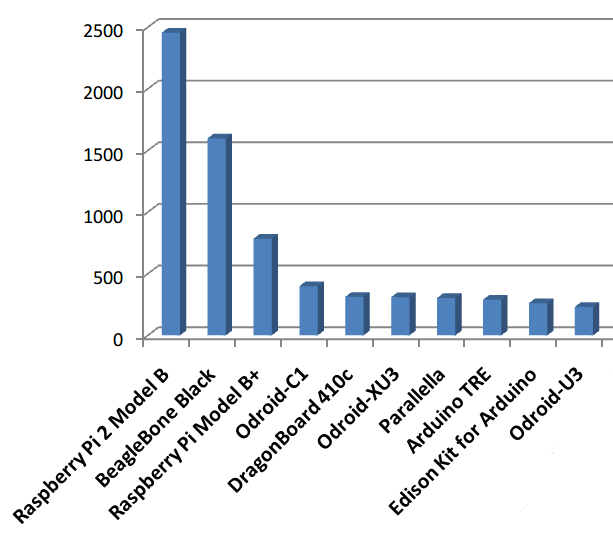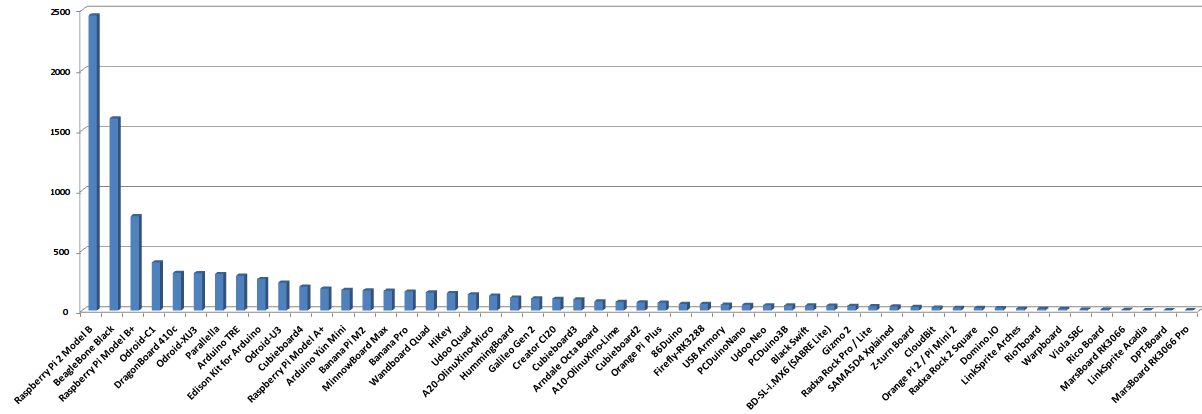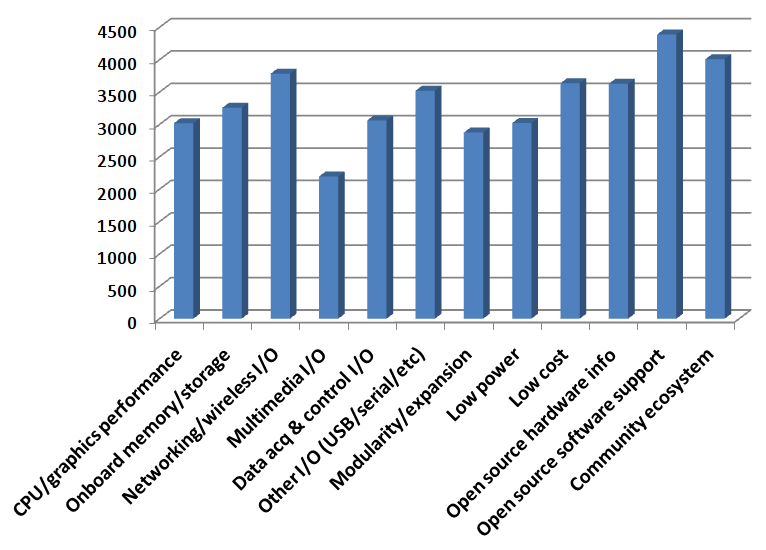 Despite all the new open source community SBCs that have arrived in the last year, the field is dominated more than ever by the Raspberry Pi. The results of our reader survey on open spec single board computers, held in conjunction with LinuxGizmos.com, are in, and as with last year’s survey, the Raspberry Pi is the winner.
Despite all the new open source community SBCs that have arrived in the last year, the field is dominated more than ever by the Raspberry Pi. The results of our reader survey on open spec single board computers, held in conjunction with LinuxGizmos.com, are in, and as with last year’s survey, the Raspberry Pi is the winner.
This time it’s the new quad-core Raspberry Pi 2 Model B, which led the second place BeagleBone Black by a score of 2,455 points to 1,598. The single-core Raspberry Pi Model B+ came in third with 784 points, or almost twice the score of the fourth place (399) Odroid-C1. A year ago, it was the RPi Model B that took first place followed by the BB Black and a different Odroid — the U3. The other boards that made it into the top 10 include Qualcomm’s DragonBoard 410c, the Odroid-XU3, the Parallella, the Arduino Tre, the Intel Edison Kit for Arduino, and the Odroid-U3. More details of the top 10 boards may be found in our slide show (see Gallery Link below).
Last month, we asked the readers of Linux.com and LinuxGizmos.com to choose their top three Linux- or Android-based open-spec single-board computers. More than 1,700 respondents – more than twice the number from the 2014 survey — selected their favorites from a list of 53 SBCs, compared to last year’s 32.
Twenty respondents were randomly selected to receive one of 20 donated community SBCs. These were equally split among Beagleboard.org’s BeagleBone Black, Imagination Technologies’ s CI20 Creator, Qualcomm’s Dragonboard 410C, and the Intel Edison Kit for Arduino. The winners are listed farther below along with a summary of reader answers to questions about buying criteria and intended applications, as well as the full ranking of the 53 boards.
Board ranking results
Note that we used the Borda Count, in which we triple the number of first choices for a particular SBC, then double the number of second place selections, and add the two results with the unadjusted third-choice figure. (See our earlier coverage for summaries of each board, as well as details on product selection and the rules of the survey.)

Hardkernel’s Odroid project had the second largest combined score for boards from a particular community or vendor, with 940 points. Even combined, that trails the BeagleBone’s 1,598 single-product total, not to mention the cumulative 3,420 points of all the RPi boards, including the 12th place Raspberry Pi Model A+.
Continuing the comparison of board families, Cubieboard’s three models combined for 357 points, Olimex’s two OLinuXino boards combined for 195, and Seco’s pair of Udoo boards chipped in for 177. LinkSprite’s two PCDuino boards combined for 88 points, and if you throw in the company’s non-Arduino compatible LinkSprite Arches and LinkSprite Acadia, you end up with 106.
The near clones of the Raspberry Pi did well, but since there are now two rival Banana Pi projects, neither made it to the top 10, as did last year’s 5th ranked Banana Pi. Instead SinoVoip’s Banana Pi M2 landed in 14th place, and LeMaker’s Banana Pi Pro is ranked 16th. The somewhat similar Orange Pi 2 trailed considerably.
Some 43 percent of participants had first-hand experience with their primary choice, down to 33 percent for the second choice and 23 percent for third. If you prefer to judge only by first place selections, the ranking stays pretty much the same at the top of the list, with a few interesting exceptions. For example, 96Board.org’s (Linaro’s) new 64-bit, ARMv8 HiKey board would have jumped into the top 10 along with Intel’s Minnowboard Max.
The Borda-ranked top 10 includes two boards that aren’t out yet, but are promised to ship before our June 2015 cutoff. Arduino LLC’s long delayed Arduino TRE appears to be finally set for takeoff this month, and Qualcomm was confident enough in the DragonBoard 410c’s ship date to contribute five boards for our contest winners. Like the HiKey, the DragonBoard 410c is the only other ARMv8 board in the contest, and similarly complies with the 96Boards.org spec.
There were no Arduino boards in last year’s contest, but Arduino was a strong contender in 2015. As the two rival Arduino factions add Linux boards to their catalog and other SBCs add Arduino shield compatibility, there has been a continuing migration of Arduino users to Linux platforms. In addition to the TRE, which came in eighth, there’s the 13th ranked Arduino Yún Mini from Arduino Srl, which split off from the Arduino LLC project. Other top 10 boards with Arduino compatibility include the DragonBoard 410c and the Intel Edison Kit for Arduino.
We almost excluded the Edison kit since the Intel Atom-based Edison itself is not an SBC, but a computer-on-module much like the Raspberry Pi Compute Module. However, we realized there has been wide adoption of the Edison when sold with the Arduino breakout, which makes it much like any other Linux hacker SBC. (See last week’s story on the NASA Space App Challenge to see some hacker projects that used the Intel Edison Kit for Arduino.
All told, the x86 based boards did a bit better than last year. These also include the Atom-based MinnowBoard Max and Quark-based Galileo, as well as the AMD G-Series driven Gizmo 2.
We gave participants the opportunity to list other boards they liked, and while the vast majority are already on our list or are slightly different SKUs of the same boards, there were some interesting additions. Among those that might actually fit our criteria, the leading choices were Inforce Computing’s Snapdragon 600 based Inforce IFC6410 and with fewer votes, the newer Snapdragon 805 based IFC6540, as well as Nvidia’s Tegra K1-based Nvidia Jetson TK1.
Other readers listed computer-on-modules, such as the Gumstix Overo or mini-PCs led by SolidRun’s CuBox models. However, we ruled out both of these categories keep  the competition more focused.
the competition more focused.
Open software leads SBC buying criteria
When we asked readers about their buying criteria for community-backed SBCs, the response was similar to last year’s. Open source software support and community ecosystem once again ranked first and second. The two go hand in hand because without the community the chances of receiving a variety of timely, high quality Linux and Android open source builds is often diminished.
All the projects promise open source firmware, usually in several flavors, but in many cases, boards ship before they’re fully supported, and some boards never receive the promised support. Even when the core distributions are crafted more by developers working for the board manufacturer or SoC vendor, rather than independent developers, the presence of a dedicated community is generally indicative of the presence of quality software.
Like last year, the tightly bunched categories of networking/wireless, low cost, and open source hardware support filled out the top five buying criteria. The Other I/O category once again ranked sixth, and was again trailed by the closely clustered memory/storage, power efficiency, and processor performance. The middling score for performance is reflected in our product rankings, where there seems to be a total lack of correlation between performance and desirability, at least once cost is factored out.
Other factors listed by readers in the comments sections primarily fell into one of the existing categories, but there were some interesting trends revealed here. Over all, the most cited mentions were for SATA support, smaller board sizes, and wider distribution networks.
Home automation leads applications list
We also asked readers to choose the chief application for their SBC projects. Participants could select as many categories as they wanted, but they were all ranked equally. Home automation once again led the list, at almost the same 59.7 percent score as last year.
This year, special function servers rose from third to second place above education, which dropped from second to fourth place behind third place home multimedia. Beyond that, robots, drones, and the like came next, followed by more industrial applications.
In the optional “other” category, the submissions tended to fit into one of our existing groupings, with many users listing specific home automation and other IoT gizmos like remote sensor applications. The applications listed here show the vast range of embedded Linux. Highlights, many of which were listed more than once, include SDR, automotive, art installations, SCADA, HPC, survey telescopes, flight recording, digital art, weather station, healthcare, 3D printer control, agronomy, model trains, payment processing, test automation, music synthesizer, environmental data logging, human sensory augmentation, security/camera automation devices, machine vision, gaming, defense, biometrics, and “in buoys.”
In a separate question, we asked readers to select the term that best described the nature of their SBC projects, this time permitting only one answer. This year, we broke out education as a separate category along with the previous maker/hobbyist and commercial/prototyping categories. Education earned a 10.5 percent score, while maker/hobbyist dropped to 67.9 percent and commercial slipped slightly to just over 18 percent.
Prize winners
Congratulations to the 20 winners of our drawing for one of 20 donated SBCs: Preetwinder Batth, Nathan Briley, Greg Chapman, Adam Coleman, Spencer Cureton, Alexandre Dauphin, Robert Dickson, Gorazd Herman, Norman Jaffe, Richard Karnesky, Nick Kartsioukas, Niels Langendorff, Andrew Lunn, Kevin Mihelich, Nick Oppen, Thomas Ozenne, Andrea Panontin, Jerahmie Radder, Tomas Rimkus, and Sverrir Steindorsson.
The table below contains scores for all 53 open SBCs in our survey sorted by Borda score, from first place (highest Borda value) to 53rd. Each set of numbers indicates the SBC’s overall weighted score, along with its first, second, and third-place votes. You can view the survey’s complete results here, or view LinuxGizmos’s coverage of the results here. Click on the Gallery link below to see our Top-10 SBC Slide Show.
| 1st Choice | 2nd Choice | 3rd Choice | Borda Score | |
|---|---|---|---|---|
| 1. Raspberry Pi 2 Model B | 564 | 294 | 175 | 2455 |
| 2. BeagleBone Black | 266 | 273 | 254 | 1598 |
| 3. Raspberry Pi Model B+ | 100 | 182 | 120 | 784 |
| 4. Odroid-C1 | 77 | 62 | 44 | 399 |
| 5. DragonBoard 410c | 53 | 54 | 45 | 312 |
| 6. Odroid-XU3 | 47 | 62 | 45 | 310 |
| 7. Parallella | 55 | 43 | 52 | 303 |
| 8. Arduino TRE | 26 | 71 | 69 | 289 |
| 9. Edison Kit for Arduino | 37 | 41 | 68 | 261 |
| 10. Odroid-U3 | 33 | 43 | 46 | 231 |
| 11. Cubieboard4 | 22 | 40 | 52 | 198 |
| 12. Raspberry Pi Model A+ | 22 | 28 | 59 | 181 |
| 13. Arduino Yún Mini | 12 | 48 | 39 | 171 |
| 14. Banana Pi M2 | 19 | 39 | 31 | 166 |
| 15. MinnowBoard Max | 28 | 25 | 30 | 164 |
| 16. Banana Pro | 25 | 30 | 22 | 157 |
| 17. Wandboard Quad | 21 | 28 | 31 | 150 |
| 18. HiKey | 36 | 12 | 13 | 145 |
| 19. Udoo Quad | 24 | 21 | 20 | 134 |
| 20. A20-OlinuXino-Micro | 25 | 17 | 15 | 124 |
| 21. HummingBoard | 13 | 16 | 36 | 107 |
| 22. Galileo Gen 2 | 9 | 21 | 32 | 101 |
| 23. Creator CI20 | 18 | 10 | 22 | 96 |
| 24. Cubieboard3 | 14 | 20 | 10 | 92 |
| 25. Arndale Octa Board | 15 | 7 | 16 | 75 |
| 26. A10-OlinuXino-Lime | 11 | 13 | 12 | 71 |
| 27. Cubieboard2 | 12 | 7 | 17 | 67 |
| 28. Orange Pi Plus | 7 | 11 | 22 | 65 |
| 29. 86Duino | 5 | 13 | 13 | 54 |
| 30. Firefly-RK3288 | 11 | 7 | 7 | 54 |
| 31. USB Armory | 10 | 5 | 8 | 48 |
| 32. PCDuinoNano | 7 | 6 | 13 | 46 |
| 33. Udoo Neo | 6 | 7 | 11 | 43 |
| 34. PCDuino3B | 8 | 6 | 6 | 42 |
| 35. Black Swift | 5 | 10 | 6 | 41 |
| 36. BD-SL-i.MX6 (SABRE Lite) | 4 | 8 | 11 | 39 |
| 37. Gizmo 2 | 4 | 10 | 6 | 38 |
| 38. Radxa Rock Pro / Lite | 7 | 3 | 9 | 36 |
| 39. SAMA5D4 Xplained | 2 | 8 | 11 | 33 |
| 40. Z-turn Board | 5 | 6 | 2 | 29 |
| 41. CloudBit | 3 | 3 | 9 | 24 |
| 42. Orange Pi 2 / Pi Mini 2 | 1 | 5 | 9 | 22 |
| 43. Radxa Rock 2 Square | 2 | 4 | 7 | 21 |
| 44. Domino.IO | 3 | 4 | 3 | 20 |
| 45. LinkSprite Arches | 1 | 2 | 8 | 15 |
| 46. RioTboard | 1 | 2 | 7 | 14 |
| 47. Warpboard | 0 | 5 | 3 | 13 |
| 48. Viola SBC | 1 | 1 | 2 | 7 |
| 49. Rico Board | 1 | 0 | 3 | 6 |
| 50. MarsBoard RK3066 | 0 | 1 | 2 | 4 |
| 51. LinkSprite Acadia | 1 | 0 | 0 | 3 |
| 52. DPT-Board | 0 | 0 | 2 | 2 |
| 53. MarsBoard RK3066 Pro | 0 | 0 | 2 | 2 |


